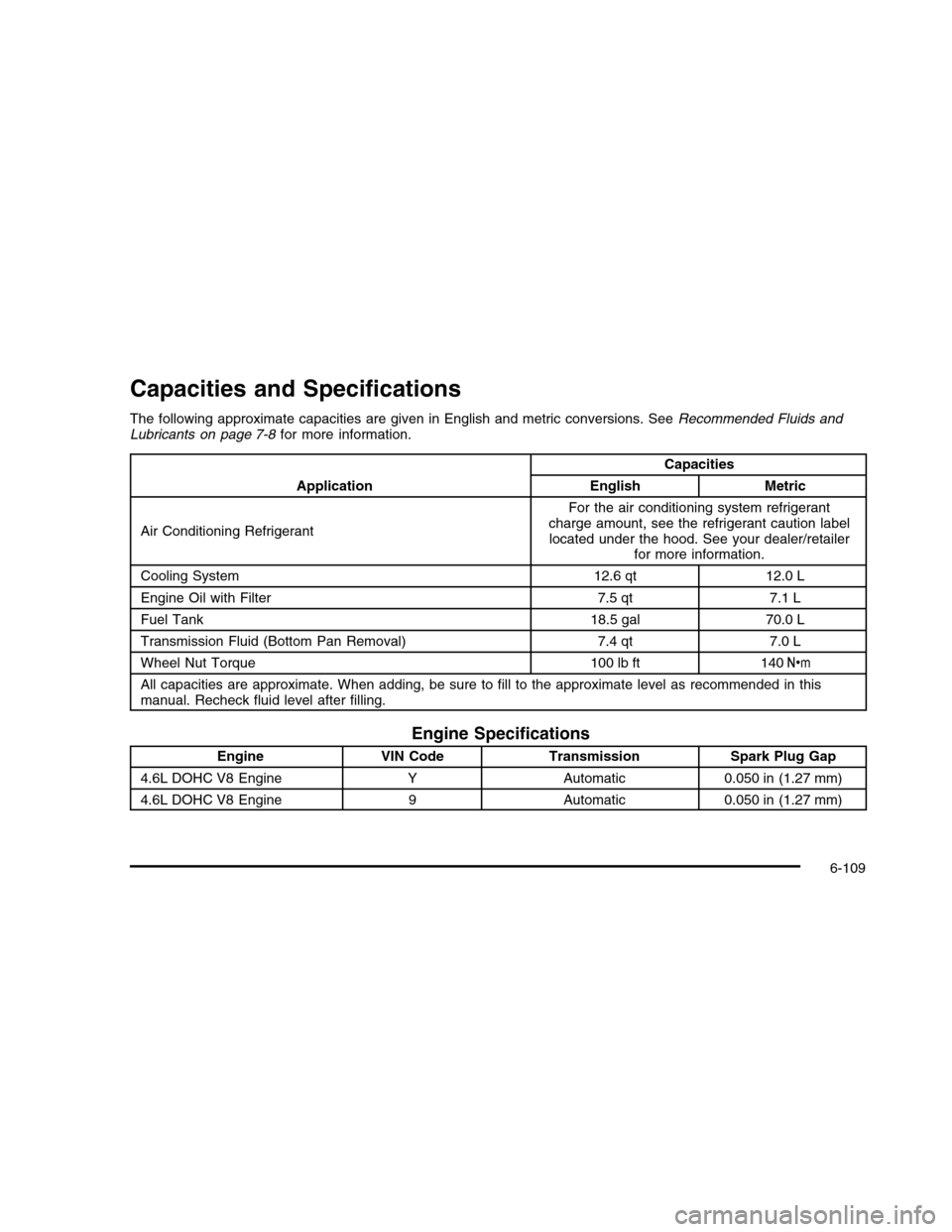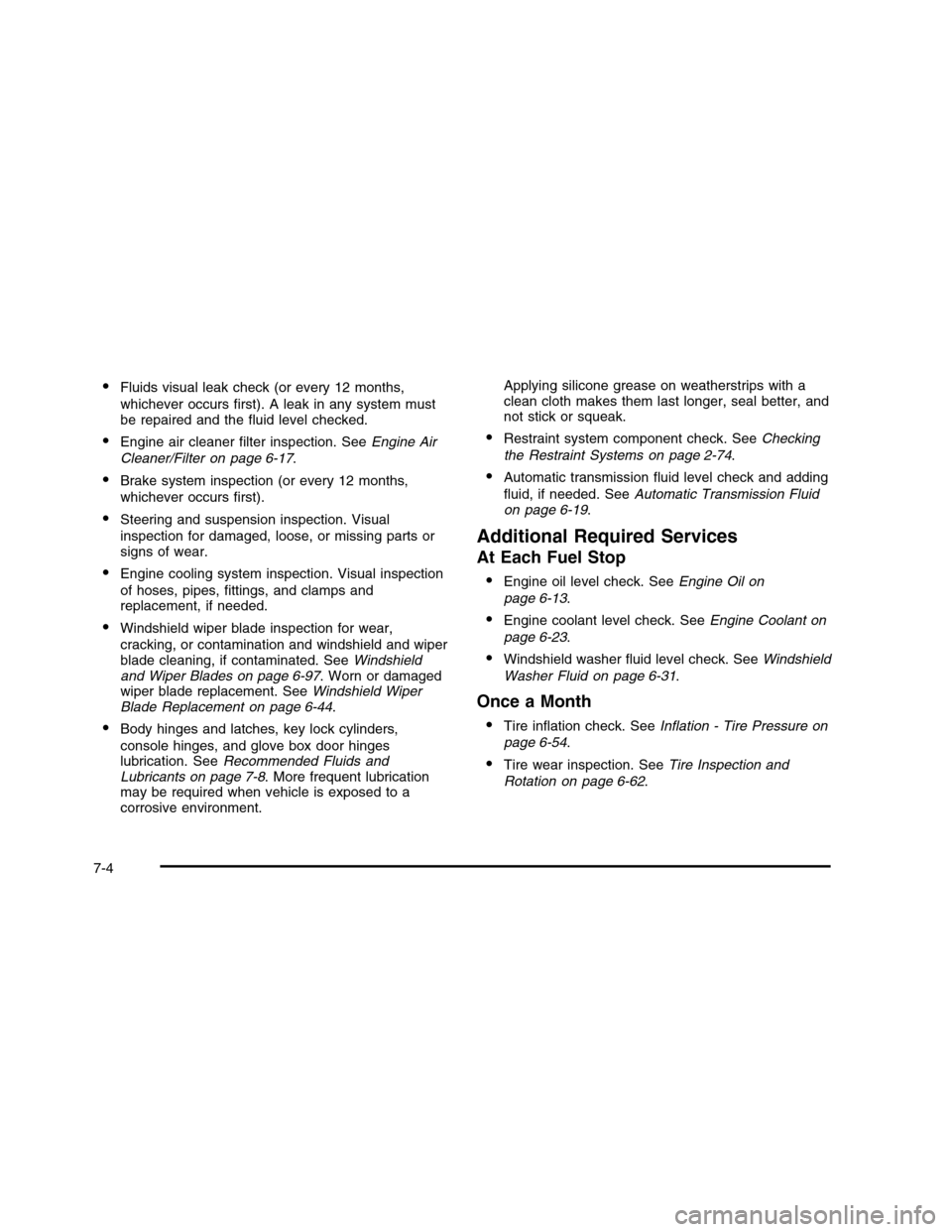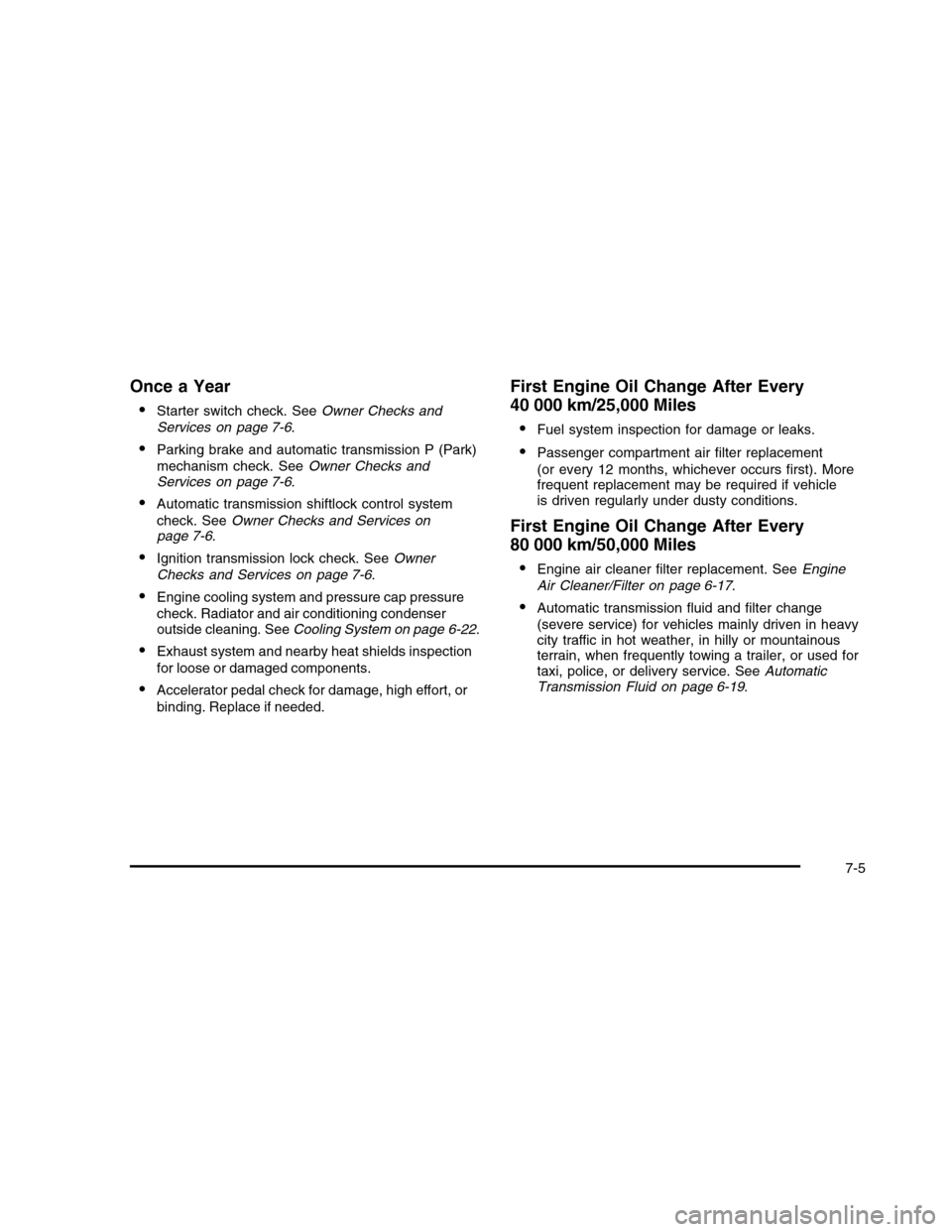check engine CADILLAC DTS 2010 1.G Owner's Guide
[x] Cancel search | Manufacturer: CADILLAC, Model Year: 2010, Model line: DTS, Model: CADILLAC DTS 2010 1.GPages: 480, PDF Size: 17.56 MB
Page 345 of 480

Checking Coolant
The vehicle must be on a level surface when checkingthe coolant level.
Check to see if coolant is visible in the coolant recoverytank. If the coolant inside the coolant recovery tank isboiling, do not do anything else until it cools down.If coolant is visible but the coolant level is not ator above the FULL COLD mark, add a 50/50 mixture ofclean, drinkable water and DEX-COOL®coolant atthe coolant recovery tank, but be sure the coolingsystem is cool before this is done. SeeEngine Coolanton page 6-23for more information.
How to Add Coolant to the Surge Tank
{WARNING:
You can be burned if you spill coolant on hot
engine parts. Coolant contains ethylene glycol and
it will burn if the engine parts are hot enough. Do
not spill coolant on a hot engine.
Notice:This vehicle has a specific coolant fillprocedure. Failure to follow this procedure couldcause the engine to overheat and be severelydamaged.
{WARNING:
An electric engine cooling fan under the hood can
start up even when the engine is not running and
can cause injury. Keep hands, clothing, and tools
away from any underhood electric fan.
6-25
Page 348 of 480

You may decide not to lift the hood when this warningappears, but instead get service help right away.SeeRoadside Service on page 8-7.
If you do decide to lift the hood, make sure the vehicleis parked on a level surface.
Then check to see if the engine cooling fans arerunning. If the engine is overheating, both fans shouldbe running. If they are not, do not continue to runthe engine and have the vehicle serviced.
Notice:Engine damage from running the enginewithout coolant is not covered by the warranty.
Notice:If the engine catches fire while driving withno coolant, the vehicle can be badly damaged.The costly repairs would not be covered bythe vehicle warranty. SeeOverheated EngineProtection Operating Mode on page 6-29forinformation on driving to a safe place in anemergency.
If Steam Is Coming From The Engine
Compartment
{WARNING:
Steam from an overheated engine can burn you
badly, even if you just open the hood. Stay away
from the engine if you see or hear steam coming
from it. Turn it off and get everyone away from the
vehicle until it cools down. Wait until there is no sign
of steam or coolant before you open the hood.
If you keep driving when the vehicles engine is
overheated, the liquids in it can catch fire. You or
others could be badly burned. Stop the engine if it
overheats, and get out of the vehicle until the
engine is cool.
SeeOverheated Engine Protection Operating Mode
on page 6-29for information on driving to a safe
place in an emergency.
6-28
Page 350 of 480

Power Steering Fluid
The power steering fluidreservoir is located next tothe underhood fuseblock on the passengerside of the vehicle.SeeEngine CompartmentOverview on page 6-12for more informationon location.
When to Check Power Steering Fluid
It is not necessary to regularly check power steering fluidunless you suspect there is a leak in the system oryou hear an unusual noise. A fluid loss in this systemcould indicate a problem. Have the system inspectedand repaired.
How to Check Power Steering Fluid
To check the power steering fluid:
1. Turn the key off and let the engine compartmentcool down.
2. Wipe the cap and the top of the reservoir clean.
3. Unscrew the cap and wipe the dipstick with a cleanrag.
4. Replace the cap and completely tighten it.
5. Remove the cap again and look at the fluid level onthe dipstick.
The level should be at the FULL COLD mark. Ifnecessary, add only enough fluid to bring the level up tothe mark.
What to Use
To determine what kind of fluid to use, seeRecommended Fluids and Lubricants on page 7-8.Always use the proper fluid.
Notice:Use of the incorrect fluid may damage thevehicle and the damages may not be covered bythe vehicle’s warranty. Always use the correct fluidlisted inRecommended Fluids and Lubricantson page 7-8.
6-30
Page 359 of 480

{WARNING:
Fans or other moving engine parts can injure you
badly. Keep your hands away from moving parts
once the engine is running.
5. Check that the jumper cables do not have loose ormissing insulation. If they do, you could get ashock. The vehicles could be damaged too.
Before you connect the cables, here are somebasic things you should know. Positive (+) will go topositive (+) or to a remote positive (+) terminal ifthe vehicle has one. Negative (!) will go to a heavy,unpainted metal engine part or to a remotenegative (!) terminal if the vehicle has one.
Do not connect positive (+) to negative (!) or youwill get a short that would damage the batteryand maybe other parts too. And do not connect thenegative (!) cable to the negative (!) terminal onthe dead battery because this can cause sparks.
6. Connect the red positive (+) cable to the remotepositive (+) terminal location on the vehicle withthe dead battery. Use a remote positive (+) terminalif the vehicle has one.
7. Do not let the other end touch metal. Connect it tothe positive (+) terminal location of the vehicle withthe good battery. Use a remote positive (+)terminal if the vehicle has one.
8. Now connect the black negative (!) cable to thenegative (!) terminal location of the vehicle withthe good battery. Use a remote negative (!) terminalif the vehicle has one.
Do not let the other end of the cable touch anythinguntil the next step. The other end of the negative (!)cable does not go to the dead battery. It goes toa heavy, unpainted metal engine part or to a remotenegative (!) terminal on the vehicle with thedead battery.
9. Connect the other end of the negative (!) cable tothe negative (!) terminal location on the vehicle withthe dead battery. Your vehicle has a remotenegative (!) terminal marked GND (!).
10. Now start the vehicle with the good battery and runthe engine for a while.
11. Try to start the vehicle that had the dead battery.If it will not start after a few tries, it probablyneeds service.
6-39
Page 429 of 480

Capacities and Specifications
The following approximate capacities are given in English and metric conversions. SeeRecommended Fluids andLubricants on page 7-8for more information.
Application
Capacities
EnglishMetric
Air Conditioning Refrigerant
For the air conditioning system refrigerantcharge amount, see the refrigerant caution labellocated under the hood. See your dealer/retailerfor more information.
Cooling System12.6 qt12.0 L
Engine Oil with Filter7.5 qt7.1 L
Fuel Tank18.5 gal70.0 L
Transmission Fluid (Bottom Pan Removal)7.4 qt7.0 L
Wheel Nut Torque100 lb ft140Y
All capacities are approximate. When adding, be sure to fill to the approximate level as recommended in thismanual. Recheck fluid level after filling.
Engine Specifications
EngineVIN CodeTransmissionSpark Plug Gap
4.6L DOHC V8 EngineYAutomatic0.050 in (1.27 mm)
4.6L DOHC V8 Engine9Automatic0.050 in (1.27 mm)
6-109
Page 431 of 480

Maintenance Schedule. . . . . . . . . . . . . . . . . . . . . . . . . . . . . . . . . . . . . .7-2Introduction . . . . . . . . . . . . . . . . . . . . . . . . . . . . . . . . . . . . . . . . . . . . . . . . . . .7-2Scheduled Maintenance . . . . . . . . . . . . . . . . . . . . . . . . . . . . . . . . . . .7-3Owner Checks and Services . . . . . . . . . . . . . . . . . . . . . . . . . . . .7-6
Recommended Fluids and Lubricants . . . . . . . . . . . . . . . .7-8Maintenance Replacement Parts . . . . . . . . . . . . . . . . . . . . .7-10Engine Drive Belt Routing . . . . . . . . . . . . . . . . . . . . . . . . . . . . . .7-11Maintenance Record . . . . . . . . . . . . . . . . . . . . . . . . . . . . . . . . . . . . .7-12
Section 7 Maintenance Schedule
7-1
Page 433 of 480

Rotation of New Tires
To maintain ride, handling, and performance of thevehicle, it is important that the first rotation service fornew tires be performed when they have 8 000 to13 000 km (5,000 to 8,000 miles). SeeTire Inspectionand Rotation on page 6-62.
Scheduled Maintenance
When the Change Engine Oil Soon
Message Displays
Change engine oil and filter. SeeEngine Oil onpage 6-13.An Emission Control Service.
When the Change Engine Oil Soon message displays,service is required for the vehicle as soon as possible,within the next 1 000 km/600 miles. If driving underthe best conditions, the engine oil life system might notindicate the need for vehicle service for more than ayear. The engine oil and filter must be changed at leastonce a year and the oil life system must be reset.Your dealer/retailer has trained service technicians whowill perform this work and reset the system.
If the engine oil life system is reset accidentally, servicethe vehicle within 5 000 km/3,000 miles since the lastservice. Reset the oil life system whenever the oilis changed. SeeEngine Oil Life System on page 6-16.
When the Change Engine Oil Soon message displays,certain services, checks, and inspections are required.
Every Engine Oil Change
•Change engine oil and filter. SeeEngine Oil on
page 6-13.An Emission Control Service.
•Engine coolant level check. SeeEngine Coolant on
page 6-23.
•Windshield washer fluid level check. SeeWindshield
Washer Fluid on page 6-31.
•Tire inflation check. SeeInflation - Tire Pressure on
page 6-54.
•Tire wear inspection. SeeTire Inspection and
Rotation on page 6-62.
•Rotate tires. SeeTire Inspection and Rotation on
page 6-62.
7-3
Page 434 of 480

•Fluids visual leak check (or every 12 months,
whichever occurs first). A leak in any system mustbe repaired and the fluid level checked.
•Engine air cleaner filter inspection. SeeEngine Air
Cleaner/Filter on page 6-17.
•Brake system inspection (or every 12 months,
whichever occurs first).
•Steering and suspension inspection. Visual
inspection for damaged, loose, or missing parts orsigns of wear.
•Engine cooling system inspection. Visual inspection
of hoses, pipes, fittings, and clamps andreplacement, if needed.
•Windshield wiper blade inspection for wear,
cracking, or contamination and windshield and wiperblade cleaning, if contaminated. SeeWindshieldand Wiper Blades on page 6-97. Worn or damagedwiper blade replacement. SeeWindshield WiperBlade Replacement on page 6-44.
•Body hinges and latches, key lock cylinders,
console hinges, and glove box door hingeslubrication. SeeRecommended Fluids andLubricants on page 7-8. More frequent lubricationmay be required when vehicle is exposed to acorrosive environment.
Applying silicone grease on weatherstrips with aclean cloth makes them last longer, seal better, andnot stick or squeak.
•Restraint system component check. SeeChecking
the Restraint Systems on page 2-74.
•Automatic transmission fluid level check and adding
fluid, if needed. SeeAutomatic Transmission Fluidon page 6-19.
Additional Required Services
At Each Fuel Stop
•Engine oil level check. SeeEngine Oil on
page 6-13.
•Engine coolant level check. SeeEngine Coolant on
page 6-23.
•Windshield washer fluid level check. SeeWindshield
Washer Fluid on page 6-31.
Once a Month
•Tire inflation check. SeeInflation - Tire Pressure on
page 6-54.
•Tire wear inspection. SeeTire Inspection and
Rotation on page 6-62.
7-4
Page 435 of 480

Once a Year
•Starter switch check. SeeOwner Checks and
Services on page 7-6.
•Parking brake and automatic transmission P (Park)
mechanism check. SeeOwner Checks andServices on page 7-6.
•Automatic transmission shiftlock control system
check. SeeOwner Checks and Services onpage 7-6.
•Ignition transmission lock check. SeeOwner
Checks and Services on page 7-6.
•Engine cooling system and pressure cap pressure
check. Radiator and air conditioning condenseroutside cleaning. SeeCooling System on page 6-22.
•Exhaust system and nearby heat shields inspection
for loose or damaged components.
•Accelerator pedal check for damage, high effort, or
binding. Replace if needed.
First Engine Oil Change After Every
40 000 km/25,000 Miles
•Fuel system inspection for damage or leaks.
•Passenger compartment air filter replacement
(or every 12 months, whichever occurs first). Morefrequent replacement may be required if vehicleis driven regularly under dusty conditions.
First Engine Oil Change After Every
80 000 km/50,000 Miles
•Engine air cleaner filter replacement. SeeEngine
Air Cleaner/Filter on page 6-17.
•Automatic transmission fluid and filter change
(severe service) for vehicles mainly driven in heavycity traffic in hot weather, in hilly or mountainousterrain, when frequently towing a trailer, or used fortaxi, police, or delivery service. SeeAutomaticTransmission Fluid on page 6-19.
7-5
Page 436 of 480

First Engine Oil Change After Every
120 000 km/75,000 Miles
•Professional Vehicle Only: Engine cooling system
drain, flush, and refill, cooling system and cappressure check, and cleaning of outside of radiatorand air conditioning condenser (or every 5 years,whichever occurs first). SeeEngine Coolanton page 6-23.An Emission Control Service.
First Engine Oil Change After Every
160 000 km/100,000 Miles
•Automatic transmission fluid and filter change
(normal service). SeeAutomatic Transmission Fluidon page 6-19.
•Spark plug replacement.An Emission Control
Service.
First Engine Oil Change After Every
240 000 km/150,000 Miles
•Except Professional Vehicle: Engine cooling system
drain, flush, and refill, cooling system and cappressure check, and cleaning of outside of radiatorand air conditioning condenser (or every 5 years,whichever occurs first). SeeEngine Coolanton page 6-23.An Emission Control Service.
•Engine accessory drive belt inspection for fraying,
excessive cracks, or obvious damage andreplacement, if needed.An Emission ControlService.
Owner Checks and Services
Starter Switch Check
{WARNING:
When you are doing this inspection, the vehicle
could move suddenly. If the vehicle moves, you or
others could be injured.
1. Before starting this check, be sure there is enoughroom around the vehicle.
2. Firmly apply both the parking brake and the regularbrake. SeeParking Brake on page 3-30.
Do not use the accelerator pedal, and be ready toturn off the engine immediately if it starts.
3. Try to start the engine in each gear. The vehicleshould start only in P (Park) or N (Neutral). If thevehicle starts in any other position, contactyour dealer/retailer for service.
7-6